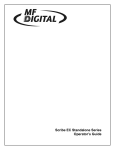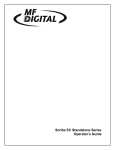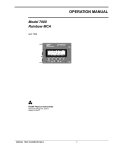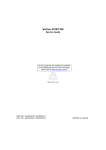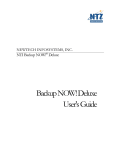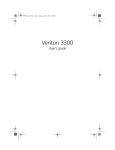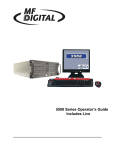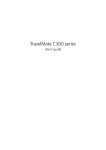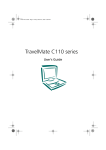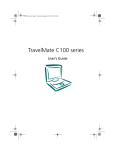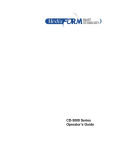Download Acer 3200 User's Manual
Transcript
ver3200AAC-0.book Page i Friday, March 2, 2001 3:52 PM Veriton 3200 User’s guide ver3200AAC-0.book Page ii Friday, March 2, 2001 3:52 PM ii Document History EDITION PART NUMBER DATE First Edition 49.38H01.081 February 2001 __________________________________________________________________________ Copyright Notice Copyright © 2001 by Acer America Corporation. All rights reserved. No part of this publication may be reproduced, transmitted, transcribed, stored in a retrieval system, or translated into any language or computer language, in any form or by any means, electronic, mechanical, magnetic, optical, chemical,manual or otherwise, without the prior written permission of Acer America Corporation. Printed in China. __________________________________________________________________________ Trademarks Acer and the Acer logo are registered trademarks of Acer Incorporated. Windows Me and Windows 2000 are registered trademarks of Microsoft Corporation. PC-cillin is a trademark of Trend Micro, Incoporated. Intel, Celeron, Pentium, and LANDesk are registered trademarks of Intel Corporation. Other brand and product names are registered trademarks or trademarks of their respective holders. __________________________________________________________________________ Disclaimer Acer and its suppliers make no representations or warranties, either expressed or implied, with respect to the contents hereof and specifically disclaim any warranties of merchantability or fitness for a particular purpose. Further, Acer reserves the right to revise this publication and to make changes from time to time in the contents hereof without obligation to notify any person of such revisions or changes. Acer reserves the right to make changes to the products described in this manual at any time and without notice. __________________________________________________________________________ ver3200AAC-0.book Page iii Friday, March 2, 2001 3:52 PM iii Warranty/Limitation of Liability Any software described in this manual is licensed “as is” and Acer and its suppliers disclaim any and all warranties, express or implied, including but not limited to any warranty of non-infringement of third party rights, merchantability or fitness for a particular purpose. Acer does not warrant that the operation of the software will be uninterrupted or error free. Should the programs prove defective, the buyer (and not Acer, its distributor, or its dealer) assumes the entire cost of all necessary service, repair, and any incidental or consequential damages resulting from any defect in the software. Please see the Acer Limited Product Warranty for details of Acer’s limited warranty on hardware products. IN NO EVENT SHALL ACER BE LIABLE FOR ANY INDIRECT OR CONSEQUENTIAL DAMAGES, INCLUDING LOSS OF PROFITS OR DATA, EVEN IF ACER HAS BEEN ADVISED OF THE POSSIBILITY OF SUCH DAMAGES. Software License Acer grants you a personal, non-transferable, non-exclusive license to use the software that accompanies your computer system only on a single computer. You may not (a) make copies of the software except for making one (1) backup copy of the software which will also be subject to this license, (b) reverse engineer, decompile, disassemble, translate or create derivative works based upon the software, (c) export or re-export the software to any person or destination which is not authorized to receive them under the export control laws and regulations of the United States, (d) remove or alter in any way the copyright notices, or other proprietary legends that were on the software as delivered to you or (e) sublicense or otherwise make the software available to third parties. The software is the property of Acer or Acer’s supplier and you do not have and shall not gain any proprietary interest in the software (including any modifications or copies made by or for you) or any related intellectual property rights. Additional restrictions may apply to certain software titles. Please refer to any software licenses that accompany such software for details. Join Us to Fight Against Piracy The Acer Group has been implementing a policy to respect and protect legitimate intellectual property rights. Acer firmly believes that only when each and every one of us abides by such policy, can this industry provide quality service to the general public. Acer has become a member of the Technology Committee of the Pacific Basin Economic Council which is encouraging the protection and enforcement of legitimate intellectual property rights worldwide. Moreover, in order to ensure quality service to all of our customers, Acer includes an operating system in Acer computer systems which is duly licensed by the legitimate proprietors and produced with quality. Acer commits itself and urges all of its customers to join the fight against intellectual property piracy wherever it may occur. Acer will pursue the enforcement of intellectual property rights and will strive to fight against piracy. ver3200AAC-0.book Page iv Friday, March 2, 2001 3:52 PM iv Notices FCC notice This device has been tested and found to comply with the limits for a Class B digital device pursuant to Part 15 of the FCC Rules. These limits are designed to provide reasonable protection against harmful interference in a residential installation. This device generates, uses, and can radiate radio frequency energy and, if not installed and used in accordance with the instructions, may cause harmful interference to radio communications. However, there is no guarantee that interference will not occur in a particular installation. If this device does cause harmful interference to radio or television reception, which can be determined by turning the device off and on, the user is encouraged to try to correct the interference by one or more of the following measures: • Reorient or relocate the receiving antenna • Increase the separation between the device and receiver • Connect the device into an outlet on a circuit different from that to which the receiver is connected • Consult the dealer or an experienced radio/television technician for help Notice: Shielded cables All connections to other computing devices must be made using shielded cables to maintain compliance with FCC regulations. Notice: Peripheral devices Only peripherals (input/output devices, terminals, printers, etc.) certified to comply with the Class B limits may be attached to this equipment. Operation with noncertified peripherals is likely to result in interference to radio and TV reception. Caution! Changes or modifications not expressly approved by the manufacturer could void the user’s authority, which is granted by the Federal Communications Commission, to operate this computer. ver3200AAC-0.book Page v Friday, March 2, 2001 3:52 PM v Use conditions This part complies with Part 15 of the FCC Rules. Operation is subject to the following two conditions: (1) this device may not cause harmful interference, and (2) this device must accept any interference received, including interference that may cause undesired operation. Notice: Canadian users This Class B digital apparatus meets all requirements of the Canadian Interference-Causing Equipment Regulations. Remarque à l’intention des utilisateurs canadiens Cet appareil numérique de la classe B respected toutes les exigences du Règlement sur le matériel brouilleur du Canada. Important safety instructions Read these instructions carefully. Save these instructions for future reference. 1. Follow all warnings and instructions marked on the product. 2. Unplug this product from the wall outlet before cleaning. Do not use liquid cleaners or aerosol cleaners. Use a damp cloth for cleaning. 3. Do not use this product near water. 4. Do not place this product on an unstable cart, stand, or table. The product may fall, causing serious damage to the product. 5. Slots and openings in the cabinet and the back or bottom are provided for ventilation; to ensure reliable operation of the product and to protect it from overheating, these openings must not be blocked or covered. The openings should never be blocked by placing the product on a bed, sofa, rug, or other similar surface. This product should never be placed near or over a radiator or heat register, or in a built-in installation unless proper ventilation is provided. 6. This product should be operated from the type of power indicated on the marking label. If you are not sure of the type of power available, consult your dealer or local power company. 7. Do not allow anything to rest on the power cord. Do not locate this product where persons will walk on the cord. ver3200AAC-0.book Page vi Friday, March 2, 2001 3:52 PM vi 8. If an extension cord is used with this product, make sure that the total ampere rating of the equipment plugged into the extension cord does not exceed the extension cord ampere rating. Also, make sure that the total rating of all products plugged into the wall outlet does not exceed the fuse rating. 9. Never push objects of any kind into this product through cabinet slots as they may touch dangerous voltage points or short out parts that could result in a fire or electric shock. Never spill liquid of any kind on the product. 10. Do not attempt to service this product yourself, as opening or removing covers may expose you to dangerous voltage points or other risks. Refer all servicing to qualified service personnel. 11. Unplug this product from the wall outlet and refer servicing to qualified service personnel under the following conditions: a. When the power cord or plug is damaged or frayed b. If liquid has been spilled into the product c. If the product has been exposed to rain or water d. If the product does not operate normally when the operating instructions are followed. Adjust only those controls that are covered by the operating instructions since improper adjustment of other controls may result in damage and will often require extensive work by a qualified technician to restore the product to normal condition. e. If the product has been dropped or the cabinet has been damaged f. If the product exhibits a distinct change in performance, indicating a need for service. 12. Replace the battery with the same type as the product's battery we recommend. Use of another battery may present a risk of fire or explosion. Refer battery replacement to a qualified serviceman. 13. Warning! Batteries may explode if not handled properly. Do not disassemble or dispose of them in fire. Keep them away from children and dispose of used batteries promptly. 14. Use only the proper type of power supply cord set (provided in your accessories box) for this unit. It should be a detachable type: UL listed/CSA certified, type SPT-2, rated 7A 125V minimum, VDE approved or its equivalent. Maximum length is 15 feet (4.6 meters). ver3200AAC-0.book Page vii Friday, March 2, 2001 3:52 PM vii Laser compliance statement The CD-ROM drive in this computer is a laser product. The CD-ROM drive’s classification label (shown below) is located on the drive. CLASS 1 LASER PRODUCT CAUTION: INVISIBLE LASER RADIATION WHEN OPEN. AVOID EXPOSURE TO BEAM. APPAREIL A LASER DE CLASSE 1 PRODUIT LASERATTENTION: RADIATION DU FAISCEAU LASER INVISIBLE EN CAS D’OUVERTURE. EVITTER TOUTE EXPOSITION AUX RAYONS. LASER KLASSE 1 VORSICHT: UNSICHTBARE LASERSTRAHLUNG, WENN ABDECKUNG GEÖFFNET, NICHT DEM STRAHLL AUSSETZEN PRODUCTO LÁSER DE LA CLASE I ADVERTENCIA: RADIACIÓN LÁSER INVISIBLE AL SER ABIERTO. EVITE EXPONERSE A LOS RAYOS. ADVARSEL: LASERSTRÅLING VEDÅBNING SE IKKE IND I STRÅLEN VARO! LAVATTAESSA OLET ALTTINA LASERSÅTEILYLLE. VARNING: LASERSTRÅLNING NÅR DENNA DEL ÅR ÖPPNAD ÅLÅ TUIJOTA SÅTEESEENSTIRRA EJ IN I STRÅLEN VARNING: LASERSTRÅLNING NAR DENNA DEL ÅR ÖPPNADSTIRRA EJ IN I STRÅLEN ADVARSEL: LASERSTRÅLING NAR DEKSEL ÅPNESSTIRR IKKE INN I STRÅLEN Lithium battery statement CAUTION Danger of explosion if battery is incorrectly replaced. Replace only with the same or equivalent type recommended by the manufacturer. Discard used batteries according to the manufacturer’s instructions. ADVARSEL! Lithiumbatteri - Eksplosionsfare ved fejlagtig håndtering. Udskiftning må kun ske med batteri af samme fabrikat og type. Léver det brugte batteri tilbage til leverandøren. ver3200AAC-0.book Page viii Friday, March 2, 2001 3:52 PM viii ADVARSEL Eksplosjonsfare ved feilaktig skifte av batteri. Benytt samme batteritype eller en tilsvarende type anbefalt av apparatfabrikanten. Brukte batterier kasseres i henhold til fabrikantens instruksjoner. VARNING Explosionsfara vid felaktigt batteribyte. Anvãnd samma batterityp eller en ekvivalent typ som rekommenderas av apparattillverkaren. Kassera anvãnt batteri enligt fabrikantens instruktion. VAROITUS Päristo voi räjähtää, jos se on virheellisesti asennettu. Vaihda paristo ainoastaan laitevalmistajan suosittelemaan tyyppiin. Hävitä käytetty paristo valmistajan ohjeiden mukaisesti. VORSICHT! Explosionsgefahr bei unsachgemäßen Austausch der Batterie Ersatz nur durch denselben oder einem vom Hersteller empfohlenem ähnlichen Typ. Entsorgung gebrauchter Batterien nach Angaben des Herstellers. Notices iv 1 First things first 1 Package contents Taking care of your computer Important tips Cleaning and servicing Asking for technical assistance Accessing the online manual 3 4 4 4 5 6 2 System tour 7 Features Performance Multimedia Connectivity Front panel Rear panel Keyboard Programmable keys Internet/Suspend keys Multimedia keys Volume control/Mute Cursor keys Lock keys Windows keys Mouse Disk drives 3.5-inch floppy disk drive CD-ROM/DVD-ROM/CD-RW drive Hard disk drive 9 9 9 10 11 13 15 15 15 16 16 16 17 17 19 20 20 21 23 3 Setting up your computer 25 Arranging a comfortable work area Adjusting your chair Positioning your Veriton PC Positioning your monitor Positioning your keyboard Positioning your mouse Connecting peripherals USB devices Monitor 27 27 27 29 29 30 31 31 33 Contents ver3200AAC-0.book Page ix Friday, March 2, 2001 3:52 PM ver3200AAC-0.book Page x Friday, March 2, 2001 3:52 PM x Power cable Turning on your computer Turning off your computer Connecting options Printer Network Modem (optional) Multimedia devices 34 35 36 37 37 38 39 40 4 Upgrading your computer 45 Installation precautions ESD precautions Preinstallation instructions Post-installation instructions Opening your computer To remove the top cover To reinstall the cover Internal components Replacing the hard disk Installing an expansion card System boards Mainboard layout Audio board Installing additional memory To remove a DIMM To install a DIMM To reconfigure your computer Upgrading the CPU To remove the CPU To install the upgrade CPU 47 47 47 48 49 49 50 51 52 58 60 60 64 65 65 66 67 68 68 69 5 Software PC-cillin LDCM NTI CD-Maker 2000 PowerDVD BIOS utility Reinstalling programs 6 Q&A 71 74 75 76 77 79 80 81 ver3200AAC-0.book Page 1 Friday, March 2, 2001 3:52 PM 1 First things first ver3200AAC-0.book Page 2 Friday, March 2, 2001 3:52 PM This chapter describes the contents of your computer package and also provides important tips on how to take care of your computer. ver3200AAC-0.book Page 3 Friday, March 2, 2001 3:52 PM 3 Package contents Before you unpack your computer, make sure that you have enough space to set up your computer. Carefully unpack the carton and remove the contents. If any of the following items are missing or damaged, contact your dealer immediately: • Veriton 3200 • Items contained in the accessory box • Foot stands • USB mouse • Power cable • USB speakers (available in select countries) • USB keyboard • User’s guide and installation poster • Other user documentation and third-party software ver3200AAC-0.book Page 4 Friday, March 2, 2001 3:52 PM 4 1 First things first Taking care of your computer Please read the important instructions listed in this section. Following these instructions will help you maximize the durability of your computer. Important tips • Do not expose the computer to direct sunlight. Do not place it near sources of heat, such as a radiator. • Do not subject the computer to magnetic fields. • Do not expose the computer to rain or moisture. • Do not spill water on the computer. • Do not subject the computer to heavy shock or vibration. • Do not expose the computer to dust and dirt. • Never place the system on uneven surfaces. • Do not step on the power cord or place heavy objects on top of it. Carefully route the power cord and any cables away from personal traffic. • When unplugging the power cord, do not pull on the cord itself but pull on the plug. • The total ampere rating of the equipment plugged in should not exceed the ampere rating of the cord if you are using an extension cord. Also, the total current rating of all equipment plugged into a single wall outlet should not exceed the fuse rating. • Check the documentation that came with your software programs to see if you can select other combinations of resolution and color. These adjustments could make viewing the screen more comfortable. Cleaning and servicing To clean your computer and keyboard 1. Turn off the computer and unplug the power cord. 2. Use a soft cloth moistened with water and gently wipe the exterior of the computer and the keyboard. Do not use liquid or aerosol cleaners. ver3200AAC-0.book Page 5 Friday, March 2, 2001 3:52 PM 5 To clean your mouse 1. Open the circular cover underneath the mouse. 2. Take out the rubber ball and wipe it with a soft, damp cloth. 3. Put the ball back and close the cover. To clean your monitor Make sure that you keep your screen clean. For cleaning instructions, refer to the documentation that came with your monitor. When to contact a service technician • If you dropped and damaged the computer. • If liquid has been spilled into the computer. • If the computer is not operating normally. Asking for technical assistance For technical assistance, contact your local dealer or distributor. You may also access the Acer Web site at http://www.acer.com/ for information on how and where to contact the service centers available in your area. ver3200AAC-0.book Page 6 Friday, March 2, 2001 3:52 PM 6 1 First things first Accessing the online manual You may also refer to the Veriton 3200 online manual for information about your computer. To access the online manual, simply double-click on the Veriton 3200 Online icon on your Windows desktop. ver3200AAC-0.book Page 7 Friday, March 2, 2001 3:52 PM 2 System tour ver3200AAC-0.book Page 8 Friday, March 2, 2001 3:52 PM This chapter discusses the features and components of your computer. ver3200AAC-0.book Page 9 Friday, March 2, 2001 3:52 PM 9 Features Here are just a few of your computer’s many features: Performance • Intel Pentium® III and Celeron processor with integrated L2 cache memory in Flip Chip (FC)-PGA 370 socket form factor • Expandable system memory to a maximum of 512 MB Note: Due to a chipset limitation you can only use two DIMM sockets (DIMM1 and DIMM2) when you install a 133 MHZ front side bus CPU. If the system has a 100 MHz front side bus CPU then you can use all of the DIMM sockets. • Power management function • Reserved keylock and intrusion alarm function • 3.5-inch floppy disk drive • CD-ROM/DVD-ROM/CD-RW drive • High-capacity, Enhanced-IDE hard disk Multimedia • 128-bit graphics accelerator onboard with an additional AGP card slot Note: The onboard VGA function will automatically be disabled when you install an AGP VGA card in the AGP slot. • 3-D quality audio system via onboard audio controller • Supports CRT (cathode-ray tube) monitors • Audio-in/Line-in, Audio-out/Line-out, Headphone-out, Mic-in, and Game/MIDI interfaces Note: The system has two microphone-in ports (front and rear). However, you can not use both of them at the same time. The default setting for your system enables the microphone-in port in front and disables the one at the back. ver3200AAC-0.book Page 10 Friday, March 2, 2001 3:52 PM 10 2 System tour Connectivity • PS/2 mouse and keyboard interface • One parallel interface and two serial interfaces (internal and external) • Universal Serial Bus (USB) ports (available on front and rear panels) • High-speed fax/data PCI modem (optional) • 10Base-T/100Base-TX network support with remote wake-up function ver3200AAC-0.book Page 11 Friday, March 2, 2001 3:52 PM 11 Front panel Your computer’s front panel consists of the following: Label Icon Component a Floppy disk drive light-emitting diode (LED) b 3.5-inch floppy disk drive c Floppy disk drive eject button d CD-ROM/DVD-ROM/CD-RW Headphone/Earphone port e Volume adjustment f CD-ROM/DVD-ROM/CD-RW LED g CD-ROM/DVD-ROM/CD-RW tray h CD-ROM/DVD-ROM/CD-RW emergency eject slot i Stop/Eject button ver3200AAC-0.book Page 12 Friday, March 2, 2001 3:52 PM 12 Label 2 System tour Icon Component j Power switch k Power LED l System activity LED m Hard disk drive activity LED n Headphone-out port o Microphone-in porta p USB ports a. The system has two microphone-in ports (front and rear). However, you can not use both of them at the same time. The default setting for your system enables the microphone-in port in front and disables the one at the back. ver3200AAC-0.book Page 13 Friday, March 2, 2001 3:52 PM 13 Rear panel Your computer’s rear panel consists of the following: Label Icon Color Component a Power supply b Voltage Selector switch c Keyhole d Green PS/2 mouse port e Gray Network port f Burgundy Parallel/Printer port g Gold Game/MIDI port h VGA porta ver3200AAC-0.book Page 14 Friday, March 2, 2001 3:52 PM 14 Label i 2 System tour Icon Color Component Black Handset/telephone line ports (optional) j Expansion slots k Microphone-in portb l Light blue Audio-in/Line-in jack m Lime Audio-out/Line-out jack n Blue CRT monitor port o Teal or Turquoise Serial port p Black USB ports q Purple PS/2 keyboard port r Power cord socket a. The CRT monitor port is automatically disabled when an add-on VGA card is installed into the system. Connect the monitor to the VGA port instead. b. The system has two microphone-in ports (front and rear). However, you can not use both of them at the same time. The default setting for your system enables the microphone-in port in front and disables the one at the back. For information on how to connect the peripherals, see “Connecting peripherals” on page 31 and “Connecting options” on page 37. ver3200AAC-0.book Page 15 Friday, March 2, 2001 3:52 PM 15 Keyboard The keyboard that came with your computer has full-sized keys that include separate cursor keys, two Windows keys, and twelve function keys. Programmable keys The programmable keys help you directly access a URL (Web site) or launch any program, file, or application in your system. The fifth key is set to launch the media player. If you want to configure the settings of each key, right-click on the Magic Keyboard icon located on your Windows desktop. Internet/Suspend keys The Internet/Suspend keys consist of three buttons: Icon Key Description Email Launches the email application that came bundled with your system. ver3200AAC-0.book Page 16 Friday, March 2, 2001 3:52 PM 16 2 System tour Icon Key Description Web browser Launches the browser application tha came bundled with your system. Suspend/ Resume Press this button to put the system to sleep. Press again to wake the system up. Multimedia keys The multimedia keys allow you to play, pause, stop, step forward, or step back a song or movie conveniently using your keyboard. Icon Key Description Play/Pause Press to start playing an audio or video file. Press again to pause. Stop Press to stop playing the audio or video file. Forward Press to skip forward to the next file and start playing. Backward Press to skip backward to the previous file and start playing. Volume control/Mute The volume control/mute knob controls the speaker volume. Turn it clockwise or counterclockwise to adjust the volume. Press it to toggle between mute and sound. Cursor keys The cursor keys, also called the arrow keys, let you move the cursor around the screen. They serve the same function as the arrow keys on the numeric keypad when the Num Lock is toggled off. ver3200AAC-0.book Page 17 Friday, March 2, 2001 3:52 PM 17 Lock keys The keyboard has three lock keys which you can toggle on and off to switch between two functions. Lock Key Description Caps Lock When activated, all alphabetic characters typed appear in uppercase (same function as pressing Shift + <letter>). Num Lock When activated, the keypad is set to numeric mode; i.e., the keys function as a calculator (complete with arithmetic operators such as +, -, *, and /). Scroll Lock When activated, the screen moves one line up or down when you press the up arrow or down arrow respectively. Take note that Scroll Lock may not work with some applications. Windows keys The keyboard has two keys that perform Windows-specific functions. Key Description Windows logo key Start button. Combinations with this key perform special functions, such as: • Windows + Tab: Activate the next Taskbar button • Windows + E: Explore My Computer • Windows + F: Find Document • Windows + M: Minimize All • Shift + Windows + M: Undo Minimize All • Windows + R: Display Run dialog box ver3200AAC-0.book Page 18 Friday, March 2, 2001 3:52 PM 18 2 System tour Key Description Application key Opens the applications context menu (same function as clicking the right button of the mouse). ver3200AAC-0.book Page 19 Friday, March 2, 2001 3:52 PM 19 Mouse Your mouse has one ratchet wheel and two buttons: a left button and a right button. Quickly pressing and releasing the buttons is called clicking. Sometimes, you will need to do a double-click (clicking the same button twice quickly) or a right-click (clicking the right button quickly). The ratchet wheel in between the two buttons is added to provide easier scrolling capability. By simply moving the wheel with your index finger, you can quickly move through multiple pages, lines, or windows. The wheel may also function as a third button allowing you to quickly click or double-click an icon or a selected item. Note: If you are left-handed, refer to your Windows manual for instructions on how to set up your mouse for left-handed use. ver3200AAC-0.book Page 20 Friday, March 2, 2001 3:52 PM 20 2 System tour Disk drives Your computer comes with the following disk drives: 3.5-inch floppy disk drive Your computer’s 3.5-inch floppy disk drive can handle 720-KB and 1.44MB capacity diskettes. The floppy diskettes are compact, lightweight, and easy to carry around. Here are some tips on how to take care of your diskettes: • Always make backup copies of the diskettes that contain important data or program files. • Keep diskettes away from magnetic fields and sources of heat. • Avoid removing a diskette from a drive when the floppy drive activity light is on. • Write-protect your diskettes to prevent accidental erasure. To do this, slide the write-protect tab to the write-protect position. Write-protected • Not write-protected When you put a label on a 3.5-inch diskette, make sure that the label is properly attached (flat on the surface) and within the labeling area (area with a slight surface depression) on the diskette. An improperly attached label may cause a diskette to get stuck in a drive when you are inserting or removing it. ver3200AAC-0.book Page 21 Friday, March 2, 2001 3:52 PM 21 CD-ROM/DVD-ROM/CD-RW drive Your computer may come with a CD-ROM, CD-RW or a DVD-ROM drive. This drive is located on the front panel of your computer. The CD-ROM drive allows you to play different types of compact discs (CDs). The DVD-ROM drive allows you to play not only old CD-ROMs, CD-I discs, and video CDs, but new digital video discs (DVDs) as well. Meanwhile the CD-RW drive allows you to record the CD-RW (recordable and rewritable) discs. CDs and DVDs, like diskettes, are also compact, lightweight, and easy to carry around. However, they are more delicate than diskettes and must be handled with extra care. To insert a CD/DVD into your computer’s CD-ROM/DVD-ROM/CD-RW drive: 1. Gently push the eject button located on the front panel. Caution! Avoid using low quality CDs, CD-Rs and CD-RWs, because they could be damaged by your computer’s CD-ROM/ DVD-ROM/CD-RW drive. ver3200AAC-0.book Page 22 Friday, March 2, 2001 3:52 PM 22 2 System tour 2. When the disc tray slides open, insert the CD/DVD. Make sure that the label or title side of the disc is facing upward. When holding a disc, hold it by the edges to avoid leaving smudges or fingerprints. 3. Push the eject button again to close the tray. To take care of your CDs and DVDs: • Keep your discs in a disk case when not in use to avoid scratches or other damage. Any kind of dirt or damage can affect the data on the disc, impair the disc lens reader on the CD-ROM/DVD-ROM/CDRW drive, or stop the computer from successfully reading the disc. • When handling discs, always hold them by the edges to avoid smudges or fingerprints. • When cleaning discs, use a clean, dust-free cloth and wipe in a straight line from the center to the edge. Do not wipe in a circular motion. • Clean your CD-ROM/DVD-ROM/CD-RW drive periodically. You may refer to the Cleaning Kit for instructions. Cleaning Kits can be purchased in any computer or electronics shop. ver3200AAC-0.book Page 23 Friday, March 2, 2001 3:52 PM 23 Hard disk drive Your computer is preinstalled with a high-capacity Enhanced-IDE (EIDE) hard disk drive. If you want to replace your hard disk or upgrade it, contact your dealer or a qualified service technician for support. ver3200AAC-0.book Page 24 Friday, March 2, 2001 3:52 PM 24 2 System tour ver3200AAC-0.book Page 25 Friday, March 2, 2001 3:52 PM 3 Setting up your computer ver3200AAC-0.book Page 26 Friday, March 2, 2001 3:52 PM This chapter contains step-by-step instructions on how to set up your computer and connect additional peripherals. ver3200AAC-0.book Page 27 Friday, March 2, 2001 3:52 PM 27 Arranging a comfortable work area Working safely begins with the arrangement of your work space and the proper use of equipment. For this reason, it is very important to take time and think about how you are going to arrange your work area. Here are some points to consider: Adjusting your chair Having the right kind of chair does not necessarily mean that you’ll be properly supported. It is necessary to adjust your chair to fit your body. Proper body posture will make you more comfortable and productive. • Avoid tilting your chair. If you have a chair that tilts, lock those tilt knobs so that your chair will not tilt forward or backward while you are using your computer. • Adjust your chair height in such a way that you can sit on it with your thighs parallel to the floor and your feet resting flat on the floor. • Rest your body on the chair back. Your torso works harder to maintain balance if you do not rest your body on the chair back. Positioning your Veriton PC You may position your computer in two ways: • Tower-like/vertical position • Regular desktop position To position your PC in the tower-like or vertical position: 1. Check the foot stands that came with your computer. 2. a. Press the notch on both sides of the foot stands. ver3200AAC-0.book Page 28 Friday, March 2, 2001 3:52 PM 28 3 Setting up your computer b. Attach the foot stands to the slots on the housing frame as shown in the figure below: To place your PC in the regular desktop position: 1. Check the foot stands that came with your computer. 2. Attach the foot stands as shown in the figure that follows. ver3200AAC-0.book Page 29 Friday, March 2, 2001 3:52 PM 29 3. Place your computer in the desired location. Take note of the following tips when selecting a location for your computer: • Do not put your computer near any equipment that might cause electromagnetic or radio frequency interference such as radio transmitters, televisions, copy machines, or heating and airconditioning equipment. • Avoid dusty areas and extremes of temperature and humidity. • You may place your computer beside your desk or under your table, as long as it does not block the space that you need for working and moving. Positioning your monitor Place your monitor at a comfortable viewing distance, usually 50 to 60 centimeters away. Adjust the display in such a way that the top of the screen is at or slightly below eye level. Positioning your keyboard The location of the keyboard is a very important factor to your posture. Placing it too far away will make your body lean forward forcing you to sit in an unnatural position. Placing it too high will add tension to your shoulder muscles. • The keyboard should be placed just above your lap. Adjust the keyboard height by flipping the folding stands located under the keyboard. • Keep your lower arms parallel to the floor as you type. Your upper arms and shoulders should be relaxed. Then try typing with a light touch. If you feel any shoulder or neck strain, stop for a while and check your posture. • Position your keyboard in front of your monitor. Putting your keyboard beside your monitor will make you turn your head while you type which could add tension to your neck muscles that may later result in neck strain. ver3200AAC-0.book Page 30 Friday, March 2, 2001 3:52 PM 30 3 Setting up your computer Positioning your mouse • The mouse should be placed on the same surface as your keyboard so that you can reach it with ease. • Adjust its position to allow enough space for movement without making you stretch or lean over. • Use your arm to move the mouse. Do not rest your wrist on the table when moving the mouse. ver3200AAC-0.book Page 31 Friday, March 2, 2001 3:52 PM 31 Connecting peripherals Setting up your computer is easy. For the most part, you only have four things to connect: the USB mouse, the USB keyboard, the monitor, and the power cable. USB devices Universal Serial Bus (USB) is a newer serial bus design that is capable of cascading low-/medium-speed peripherals (less than 12 Mbps) such as a keyboard, mouse, speakers, joystick, scanner, printer and modem. With USB, complex cable connections can be eliminated. Your computer comes with four USB ports: two each on both the front and rear panels. These ports allow you to connect additional serial devices to your computer without using up its system resources. Your computer comes with a USB keyboard and a USB mouse. To connect a USB device, simply plug the device cable into any of the USB ports (black ports). Note: Front and back USB ports are functional after the OS is loaded. Only the back USB port are functional during the initial boot screens. ver3200AAC-0.book Page 32 Friday, March 2, 2001 3:52 PM 32 3 Setting up your computer Note: Most USB devices have a built-in USB port which allows you to daisy-chain other devices. ver3200AAC-0.book Page 33 Friday, March 2, 2001 3:52 PM 33 Monitor To connect a monitor, simply plug the monitor cable into the monitor port (blue port) located on the rear panel of your computer. Note: The CRT monitor port is automatically disabled when an add-on VGA card is installed into the system. Connect the monitor to the VGA port instead. Note: Refer to the monitor manual for additonal instructions and information. ver3200AAC-0.book Page 34 Friday, March 2, 2001 3:52 PM 34 3 Setting up your computer Power cable Caution! Before you proceed, check the voltage range in your area. Make sure that it matches your computer’s voltage setting (see the voltage selector switch located on the rear panel of your computer). If they don’t match, change your computer’s voltage setting according to your area’s voltage range. Plug the power cable into the power cable socket located on the rear panel of your computer. Then plug the other end of the power cable into a power outlet. ver3200AAC-0.book Page 35 Friday, March 2, 2001 3:52 PM 35 Turning on your computer After connecting the necessary peripherals and plugging in the power cable, you are now ready to turn the computer on and get to work. To turn on your computer: 1. Turn on all peripherals connected to your computer such as the monitor, printer, fax, speakers, etc. 2. On the front panel of your computer, press the power button. Important: Make sure that the power cable is properly plugged into an electrical outlet. If you are using a power strip or an AVR (Auto-Voltage Regulator), make sure that it is plugged in and turned on. ver3200AAC-0.book Page 36 Friday, March 2, 2001 3:52 PM 36 3 Setting up your computer Turning off your computer To turn off your computer, do either of the following: • From your Windows desktop, click on Start, Shut Down... and select Shut down; then click on OK. • Turn off all peripherals connected to your computer, and then, press the power switch for at least four seconds. Quickly pressing the button may put the computer in Suspend mode only. ver3200AAC-0.book Page 37 Friday, March 2, 2001 3:52 PM 37 Connecting options Printer To connect a printer, plug the printer cable into the parallel port (burgundy port) located on the rear panel of your computer. ver3200AAC-0.book Page 38 Friday, March 2, 2001 3:52 PM 38 3 Setting up your computer Network You can connect your computer to a Local Area Network (LAN) using a network cable. To do so, simply plug the network cable into the network port (gray port) on the rear panel of your computer. Note: Consult your operating system manual for information on how to configure your network setup. ver3200AAC-0.book Page 39 Friday, March 2, 2001 3:52 PM 39 Modem (optional) Set up your modem connection by plugging the telephone line and handset your computer. into their corresponding ports on the rear panel of Refer to the figure below for the connections. ver3200AAC-0.book Page 40 Friday, March 2, 2001 3:52 PM 40 3 Setting up your computer Multimedia devices You can connect multimedia devices such as a microphone, headphones or earphones, speakers, an external CD player and a joystick (for games). These devices will allow you to take advantage of your computer’s multimedia features. Plug the devices in as follows: • microphone: connects to the Mic-in port (pink port) located on the front and rear panel of your computer Note: The system has two microphone-in ports (front and rear). However, you can not use both of them at the same time. The default setting for your system enables the microphone-in port in front and disables the one at the back. ver3200AAC-0.book Page 41 Friday, March 2, 2001 3:52 PM 41 • earphones, headphones: connect to the Headphone-out port (lime port) located on the front panel of your computer Note: To adjust the volume of the headphones, click on the Volume icon located on the taskbar at the bottom of your screen. When the volume control pops up, drag the volume control lever to the desired level. • speakers: connect to the Audio-out/Line-out jack located on the rear panel of your computer (lime jack) ver3200AAC-0.book Page 42 Friday, March 2, 2001 3:52 PM 42 3 Setting up your computer Note: You may also connect the USB speakers to the PS/2 port via use of a USB-to-PS/2 connector. The USB-to-PS/2 connector can only be used with the bundled speakers. It will not work with other USB devices such as a USB mouse, USB keyboard, etc. • external CD player: connects to the Audio-in/Line-in jack blue jack) located on the rear panel of your computer (light ver3200AAC-0.book Page 43 Friday, March 2, 2001 3:52 PM 43 • joystick: connects to the Game/MIDI port the rear panel of your computer (gold port) located on Note: For information on how to configure multimedia devices, consult the documentation that came with each device. ver3200AAC-0.book Page 44 Friday, March 2, 2001 3:52 PM 44 3 Setting up your computer ver3200AAC-0.book Page 45 Friday, March 2, 2001 3:52 PM 4 Upgrading your computer ver3200AAC-0.book Page 46 Friday, March 2, 2001 3:52 PM This chapter contains instructions on how to upgrade your computer and basic information about your system boards that you will find helpful when performing the upgrade process. ver3200AAC-0.book Page 47 Friday, March 2, 2001 3:52 PM 47 Installation precautions Before you install any computer component, we recommend that you read the following sections. These sections contain important ESD precautions along with preinstallation and post-installation instructions. ESD precautions Electrostatic discharge (ESD) can damage your processor, disk drives, expansion boards, and other components. Always observe the following precautions before you install a computer component: 1. Do not remove a component from its protective packaging until you are ready to install it. 2. Wear a wrist grounding strap and attach it to a metal part of the computer before handling components. If a wrist strap is not available, maintain contact with the computer throughout any procedure requiring ESD protection. Preinstallation instructions Always observe the following before you install any component: 1. Turn off your computer and all the peripherals connected to it before opening it. Then unplug all cables from the power outlets. 2. Open your computer according to the instructions on page 49. 3. Follow the ESD precautions described above before handling a computer component. 4. Remove any expansion boards or peripherals that block access to the DIMM sockets or component connector. 5. See the following sections for specific instructions on the component you wish to install. Warning! Not turning off the computer properly before you start installing the components may cause serious damage. Do not attempt the procedures described in the following sections unless you are a qualified service technician. ver3200AAC-0.book Page 48 Friday, March 2, 2001 3:52 PM 48 4 Upgrading your computer Post-installation instructions Observe the following after installing a computer component: 1. See to it that the components are installed according to the stepby-step instructions in their respective sections. 2. Replace any expansion boards or peripherals that you removed earlier. 3. Replace the computer cover. 4. Connect the necessary cables and turn on your computer. ver3200AAC-0.book Page 49 Friday, March 2, 2001 3:52 PM 49 Opening your computer Caution: Before you proceed, make sure that you have turned off your computer and all peripherals connected to it. Read the “Preinstallation instructions” on page 47. You need to open your computer before you can install additional components. See the following section for instructions. To remove the top cover 1. Turn off your computer and unplug all cables. 2. Place your computer on a flat, steady surface. If your computer is in the vertical position, remove the foot stands and place your computer in the regular desktop position. 3. Remove the two screws from the rear panel using a screwdriver. Set the screws aside. Hold the sides of the cover with both hands. Slide it back about an inch and then gently lift it upward to detach it. ver3200AAC-0.book Page 50 Friday, March 2, 2001 3:52 PM 50 4 Upgrading your computer To reinstall the cover 1. Align the cover’s hinges to the housing frame and then gently push it in to slide it back into place. 2. Secure the cover with two screws. ver3200AAC-0.book Page 51 Friday, March 2, 2001 3:52 PM 51 Internal components The figure below shows what your computer looks like once you remove the cover: Number Component 1 3.5-inch floppy disk drive 2 CD-ROM/DVD-ROM/CD-RW drive 3 Drive frame 4 Power supply 5 Mainboard 6 VGA card (optional) 7 Modem card (optional) 8 Expansion slot ver3200AAC-0.book Page 52 Friday, March 2, 2001 3:52 PM 52 4 Upgrading your computer Replacing the hard disk Follow these steps to replace your computer’s hard disk drive: 1. Remove the cover (see page 49). 2. Detach all cables connected to the CD-ROM/DVD-ROM/CD-RW and 3.5-inch floppy disk drives. 3. Press the tabs on both sides of the drive frame to release it from the housing. Rotate the drive frame to a 90-degree angle. ver3200AAC-0.book Page 53 Friday, March 2, 2001 3:52 PM 53 4. Pull the drive frame away from the housing. 5. Detach the power and disk drive cables from the hard disk drive. Remove the screw that holds the hard disk drive to the housing. Set the screw aside. ver3200AAC-0.book Page 54 Friday, March 2, 2001 3:52 PM 54 4 Upgrading your computer 6. Hold the hard disk drive frame, slide it to the right and then gently move it inward to detach it (see figure below). 7. Remove the four screws that hold the hard disk drive to the drive frame and detach the hard disk drive. Set the screws aside. ver3200AAC-0.book Page 55 Friday, March 2, 2001 3:52 PM 55 8. Insert the new hard disk drive into the frame and secure it with the four screws. 9. Reinstall the drive frame into the housing (see figures below). ver3200AAC-0.book Page 56 Friday, March 2, 2001 3:52 PM 56 4 Upgrading your computer 10. Reinstall the CD-ROM/DVD-ROM/CD-RW and 3.5-inch floppy disk drive frame into the housing (see figures below). Make sure that the tabs on both sides snap into place. 11. Reattach the CD-ROM/DVD-ROM/CD-RW and the 3.5-inch floppy disk drive cables. ver3200AAC-0.book Page 57 Friday, March 2, 2001 3:52 PM 57 Note: Make sure that the other ends of the disk cables are securely connected to their corresponding connectors on the mainboard. 12. Reinstall the cover (see page 50). ver3200AAC-0.book Page 58 Friday, March 2, 2001 3:52 PM 58 4 Upgrading your computer Installing an expansion card Note: Observe the “Installation precautions” on page 47 when installing or removing a computer component. To install an expansion card: Caution! The system accepts low profile PCI cards only. 1. Remove the cover (see page 49). 2. Locate an empty PCI slot on the mainboard. 3. Remove the screw that holds the bracket to the computer. Save the screw. 4. Pull out the bracket on the housing opposite the selected empty slot. 5. Remove the expansion card from its protective packaging. ver3200AAC-0.book Page 59 Friday, March 2, 2001 3:52 PM 59 6. Align the card with the empty bracket and then insert it into the slot. Make sure that the card is properly seated. 7. Secure the card to your computer with a screw. 8. Reinstall the cover (see page 50). When you turn on the computer, BIOS (Basic Input/Output System) automatically detects and assigns resources to the newly-installed devices. ver3200AAC-0.book Page 60 Friday, March 2, 2001 3:52 PM 60 4 Upgrading your computer System boards Mainboard layout The mainboard becomes accessible once you open your computer. It should look like the figure shown below: ver3200AAC-0.book Page 61 Friday, March 2, 2001 3:52 PM 61 Label Component ACT Turbo/LAN active LED connector AOL Alert on LAN connector AUDIO2 Audio connector for USB-audio board BT1 Battery BZ1 Buzzer CD-IN CD-ROM audio connector CN2 PS/2 mouse (upper) and keyboard (lower) ports CN3 Network (upper) and USB (lower) ports CN8 MIDI/game (upper), line-out (left), line-in (middle), and mic-in (right) ports CN10 AGP slot CN19 Parallel (upper), VGA (lower right) and serial port 1 (lower left) ports COM2 Serial port 2 (COM2) connector (optional) DIMM1 to 3 DIMM sockets 1 to 3 FAX-VOICE More voice input for modem card FDC Floppy disk drive connector FN2 3-pin CPU fan connector IDELED IDE LED connector IDE1 IDE 1 HDD connector IDE2 IDE 2 HDD connector INTRUDER Intrusion alarm connector ver3200AAC-0.book Page 62 Friday, March 2, 2001 3:52 PM 62 4 Upgrading your computer Label Component JP3 LAN EEPROM Enabled: 1-2* Disabled: 2-3 JPXA Boot block Enabled: 1-2 Disabled: 2-3* JPXB Check password Enabled: 1-2 Disabled: 2-3* JPX1 CMOS clear Clear CMOS: Normal: JPX2 CPU speed Safe mode: Normal: JPX3 1-2 2-3* 1-2 2-3* Support CPU Coppermine/Celeron: 1-2* VIA (Cyrix)/Joshua: 2-3 JPX4 Onboard LAN Enabled: 1-2* Disabled: 2-3 PS-ON ATX power switch PWR ATX power connector PWRLED Power LED connector SL1 to 3 PCI slots 1 to 3 USB2 USB connector for USB-audio board U4 FC-PGA CPU socket U10 Intel 82815 Chipset ver3200AAC-0.book Page 63 Friday, March 2, 2001 3:52 PM 63 Label Component U13 Super I/O chipset U14 Firmware HUB (BIOS) U17 Audio chipset U19 Intel 82801BA Chipset WOL Wake on LAN connector ver3200AAC-0.book Page 64 Friday, March 2, 2001 3:52 PM 64 4 Upgrading your computer Audio board The audio board that came with your computer should look like the figure that follows. Label Description JP1 Audio connector - connects to the AUDIO2 connector of the mainboard CN1 USB connector - connects to the USB2 connector of the mainboard CN2 and CN3 USB ports JK1 Microphone-in porta JK2 Audio-out port a. The system has two microphone-in ports (front and rear). However, you can not use both of them at the same time. The default setting for your system enables the microphone-in port in front and disables the one at the back. ver3200AAC-0.book Page 65 Friday, March 2, 2001 3:52 PM 65 Installing additional memory The three 168-pin sockets on board support Synchronous Dynamic Random-Access Memory (SDRAM)-type DIMMs. You may install 32-MB, 64-MB, 128-MB, or 256-MB single and double density for a maximum memory capacity of 512-MB. Note: Due to a chipset limitation you can only use two DIMM sockets (DIMM1 and DIMM2) when you install a 133 MHZ front side bus CPU. If you install a 100 MHz front side bus CPU then you can use all three DIMM sockets. However, the maximum memory capacity still applies when using three DIMM sockets. The SDRAM DIMMs should work under 3.3 volts; 5-volt memory devices are not supported. Both PC-100 (100MHz) and PC-133 (133 MHz) SDRAM can be installed on the mainboard; however, they cannot be used at the same time in a computer. Contact your dealer for qualified DIMM vendors. Caution! Do not use both PC-100 and PC-133 SDRAM together. Such a combination might cause your computer to malfunction. Each of the DIMM sockets is independent from each other. This independence allows you to install DIMMs with different capacities to form different configurations. To remove a DIMM Note: Observe the “Installation precautions” on page 47 when installing or removing a computer component. Also, make sure that you have removed the computer cover (see page 49). 1. Press the holding clips on both sides of the DIMM socket outward to release the DIMM (see step 1 in the figure). ver3200AAC-0.book Page 66 Friday, March 2, 2001 3:52 PM 66 2. 4 Upgrading your computer Gently pull the DIMM out of the socket (see step 2 in the figure). To install a DIMM Note: Observe the “Installation precautions” on page 47 when installing or removing a computer component. Also, make sure that you have removed the computer cover (see page 49). 1. Open the clips on the socket. 2. Align the DIMM with the socket. 3. Press the DIMM into the socket until the clips lock onto the DIMM. ver3200AAC-0.book Page 67 Friday, March 2, 2001 3:52 PM 67 Note: The DIMM socket is slotted to ensure proper installation. If you insert a DIMM but it does not fit easily into the socket, you may have inserted it incorrectly. Turn the DIMM around and try to insert it again. To reconfigure your computer Your computer automatically detects the amount of memory installed. Run the BIOS utility to view the new value for total system memory and make a note of it. For more information on BIOS, refer to the Veriton 3200 online manual (see “Accessing the online manual” on page 6). ver3200AAC-0.book Page 68 Friday, March 2, 2001 3:52 PM 68 4 Upgrading your computer Upgrading the CPU Note: Observe the “Installation precautions” on page 47 when installing or removing a computer component. Also, make sure that you have removed the computer cover (see page 49). To remove the CPU Before you can replace or upgrade your processor, you need to remove the previously installed processor on the mainboard. Follow these steps to remove the CPU: 1. On the mainboard, locate the CPU mounted on the socket. 2. Detach the fan/heatsink cable connector. Insert a flat screwdriver into the fan/heatsink metal bracket, press down and pry the screwdriver outward to detach the metal bracket from the socket. 3. Remove the fan/heatsink from the CPU. ver3200AAC-0.book Page 69 Friday, March 2, 2001 3:52 PM 69 4. Lift up the socket lever and then pull the CPU out of the socket. To install the upgrade CPU Before you proceed, make sure that there is no CPU installed in the CPU socket. Follow these steps to install the upgrade CPU: 1. Lift up the socket lever. 2. Insert the CPU, making sure that pin 1 (indicated by a notched corner) of the CPU connects to hole 1 of the socket (the bottom right corner). Press down the socket lever to lock the CPU into the socket. ver3200AAC-0.book Page 70 Friday, March 2, 2001 3:52 PM 70 4 Upgrading your computer 3. Attach the heatsink and fan to the CPU. Make sure that the metal brackets on both sides securely lock the heatsink and fan into place. 4. Plug the fan/heatsink cable into the fan connector on the mainboard. See “Mainboard layout” on page 60 for the location of the connectors on the mainboard. Warning! The heatsink becomes very hot when the computer is on. Never touch the heatsink with any metal or with your hands. ver3200AAC-0.book Page 71 Friday, March 2, 2001 3:52 PM 5 Software ver3200AAC-0.book Page 72 Friday, March 2, 2001 3:52 PM This chapter describes the applications that came with your computer. ver3200AAC-0.book Page 73 Friday, March 2, 2001 3:52 PM 73 Your computer comes with the following applications: • PC-cillin • LDCM • NTI CD-Maker 2000 • Power DVD • BIOS utility All of the applications that came with your computer are very easy to use. However, if you need more help and information, you may refer to the online help documentation provided in each software application. ver3200AAC-0.book Page 74 Friday, March 2, 2001 3:52 PM 74 5 Software PC-cillin PC-cillin is an antivirus program designed to scan and clean computer viruses from your computer’s hard drive and floppy drive. To ensure the integrity of your computer data, you should scan your hard drive on a regular basis. Fixes for newly-discovered viruses may not be included in the software provided with your computer. You may contact your software vendor or Trend Micro’s Web site (www.trendmicro.com) for updates. To run PC-cillin: 1. Select the PC-cillin icon from your Windows desktop. 2. Select the drives, directories, or files that you want to scan. 3. Select the scan option to begin the virus check. If PC-cillin finds any infected files, it will list several options for you to follow. ver3200AAC-0.book Page 75 Friday, March 2, 2001 3:52 PM 75 LDCM LANDesk Client Manager (LDCM) allows desktop management via the Web, standard network, or dial-up connections. It is compatible with the leading management specifications, such as Wired for Management 2.0, Desktop Management Interface (DMI) v2.0, and others. The basic features of the LDCM are as follows: • System Information - helps locate available computers in your network and collects general computer information like operating system, protocols, addresses, etc. • Configuration Information - shows the configuration of every device (i.e., BIOS, I/O ports, hard disks, network interface cards, etc.) installed in every computer in a network. • Fault Management - checks the computers for hardware errors and observes whether or not a certain device has exceeded its threshold value. If so, the program notifies the system administrator or take some action to protect it from further damage. LDCM may not be preloaded on your computer. In such a case, you will need to install it. To do so, do the following: 1. Make sure that your computer is turned on. 2. Insert the Programs CD that came with your computer into the CDROM/DVD-ROM/CD-R/W drive. Caution! Make sure that the CD is properly inserted into the CDROM/DVD-ROM/CD-R/W drive. Improper insertion may damage both the CD and the disc drive. For instructions, please see “To insert a CD/DVD into your computer’s CD-ROM/DVD-ROM/CD-RW drive:” on page 21. 3. Follow all onscreen instructions until you finish the installation. Note: LDCM currently supports Windows Me and Windows 2000. ver3200AAC-0.book Page 76 Friday, March 2, 2001 3:52 PM 76 5 Software NTI CD-Maker 2000 The NTI CD-Maker 2000 is a CD-Recording software which allows you to create and copy audio, data and videos to CD-R/W discs. The basic features of the CD-Maker 2000 are as follows: 1. Easy Step Interface - to create and write the CD, simply dragand-drop desired files from the Windows Explorer panel into the layout area. 2. CD Copy - to make exact duplicates of a CD, copy the source disc to a hard disk, or copy directly from CD to CD on-the-fly. 3. Audio CD - to record CD-DA, WAV & MP3 files to the CD, convert MP3 files to WAV or CD-DA tracks during recording, and play (preview) audio tracks using the installed media player. 4. Data CD - supports multiple file system (i.e., Joliet, MS-DOS, ISO9660 and Romeo) naming conventions, CD-ROM and CD-ROM XA formats, automatically senses any sessions recorded on a disc and allows you to create a bootable CD. 5. Mixed-Mode CD - to record in Mixed-Mode CD format: data session, followed by audio session. 6. CD Extra - to record in CD Extra format: audio session, followed by data session. Manual Installation Instruction 1. Insert the Acer System Resource CD and wait for the Acer Resource window to appear. 2. From the Menu select Application. 3. When the Software List Window appears, double-click on NTI CDMaker. 4. Follow the onscreen prompts to complete the NTI CD-Maker installation. For more information about how to use the NTI CD-Maker 2000, you may refer to the NTI CD-Maker 2000 Help menu. ver3200AAC-0.book Page 77 Friday, March 2, 2001 3:52 PM 77 PowerDVD PowerDVD is a high quality, pure software DVD player which brings high-quality movies and karaoke into your multimedia PC. You may play back high resolution DVD titles or MPEG-2 files with MPEG-2 video and Dolby AC-3 audio. PowerDVD provides a complete set of commands for navigation and advanced features such as multi-angle switching, multi-language and multi-subtitle selection, and parental control is provided. It also has the i-Power Internet Enabling feature, which links to online DVD resources via the PowerDVD Desktop Portal Page. Main features of PowerDVD video include: 1. High Quality Video Playback - plays DVD movie titles at full 24 or 30 frames per second. 2. Dolby Digital Certified - audio decoding engine of PowerDVD is certified by Dolby to meet high quality audio requirements. 3. Dolby Headphone Technology - provides optimized sound in various setting and five speaker surround sound playback, with standard stereo headphones. 4. AB Repeat Mode - plays a selection of the DVD title continuously until cancellation. 5. Digital Zoom Function - videos can be zoomed in by either 4x or 9x the normal screen ratio. 6. Tool Bar Navigator - maximum video playback control of the DVD titles. 7. Multiple Playback Commands - provides playback control of the DVD title with a multitude of options - Fast or Slow Forward and Backward, Step Forward (by multiple frames), and Step Backward. 8. Dual Playback Modes for Widescreen Titles - views DVD titles in Pan-Scan mode (full screen view on a 4:3 screen) or Letterbox (black strips added above and below the picture to give a look similar to what is viewed on a wide screen). 9. i-Power Internet Connection - activates the PowerDVD Desktop Portal Page. The Desktop Portal Page offers useful links to DVD resources, such as up-to-date news on the DVD industry and technology, DVD movie database and places to share discussions and forums with other DVD enthusiasts. ver3200AAC-0.book Page 78 Friday, March 2, 2001 3:52 PM 78 5 Software 10. Dynamic Skin Technology - offers five skin design selections to dynamically change the look of your interface. 11. Bookmark Function - allows you to save your favorite scenes so that you can return to them directly, at a later time. Includes a user-friendly viewer mode, making it simple to get the desired scenes. 12. On Screen Display - for using the selected functions of the PowerDVD to control its functions without bringing up the user interface. 13. Dual Subtitles for Language Learning - displays two subtitles simultaneously on the screen, which is great for language learning. 14. Multifunctional Screen Capture - allows you to capture images from a movie and save them to a file, your dekstop or the clipboard. 15. Closed Caption Decoder - provides a feature enhancement for those who are hearing impaired. It uses the ability to watch a DVD title with closed captioning. 16. Low CPU consumption - allows you to run background tasks on the computer while playing DVD titles. For more information about the PowerDVD, you may refer to the online help in the PowerDVD software. ver3200AAC-0.book Page 79 Friday, March 2, 2001 3:52 PM 79 BIOS utility The BIOS utility is a hardware configuration program built into your computer's Basic Input/Output System (BIOS). Since most computers are already properly configured and optimized, there is no need to run this utility. However, if you encounter configuration problems and get the "Run Setup" message, you will need to run this utility. Note: Before you run BIOS, make sure that you have saved all open files. The computer reboots immediately after you exit Setup. To run the BIOS utility, press the key combination Ctrl+Alt+Esc. For information about BIOS and how to configure your computer, refer to the Veriton 3200 online manual (see “Accessing the online manual” on page 6). ver3200AAC-0.book Page 80 Friday, March 2, 2001 3:52 PM 80 5 Software Reinstalling programs If you uninstall one of the preinstalled programs and want to reinstall it, do the following: 1. Make sure that the computer is turned on and in the Windows OS. 2. Insert the Resource CD into the CD-ROM/DVD-ROM/CD-RW drive. 3. Select the application that you want to reinstall. 4. Follow all onscreen instructions until you finish the installation. ver3200AAC-0.book Page 81 Friday, March 2, 2001 3:52 PM 6 Q&A ver3200AAC-0.book Page 82 Friday, March 2, 2001 3:52 PM This chapter tells you what to do in case your computer is not working properly. However, if a more serious problem arises, contact your dealer or the technical support center for assistance. ver3200AAC-0.book Page 83 Friday, March 2, 2001 3:52 PM 83 The following questions are possible situations that may arise during the use of your computer and each is followed by easy answers and solutions to the situation. Q: I pressed on the power switch but the system did not boot up. A: Check the LED located at the center of the power switch. If the LED is not lit, no power is being applied to the system. Do any of the following: • Check if you plugged the power cable properly into an electrical outlet. • If you are using a power strip or AVR, make sure that it is plugged in and turned on. If the LED is lit, check the following: • Is a nonbootable (nonsystem) diskette in the floppy drive? If yes, remove or replace it with a system diskette and press Ctrl + Alt + Del to restart your computer. • The operating system files may be damaged or missing. Insert the startup disk you created during Windows setup into the floppy disk drive and press Ctrl + Alt + Del to restart your computer. This will automatically diagnose your system and make necessary fixes. Q: Nothing appears on the screen. A: Your computer’s power management function automatically blanks the screen to save power. Press any key to turn the display back on. If pressing a key does not work, you can restart your computer. If restarting your computer does not work, contact your dealer or the technical support center for support. Q: The printer does not work. A: Do the following: • Make sure that the printer is connected to a power outlet and that it is turned on. • Make sure that the printer cable is connected securely to the system’s parallel port and the corresponding port on the printer. See “Printer” on page 37 for information on how to connect the printer to your computer. ver3200AAC-0.book Page 84 Friday, March 2, 2001 3:52 PM 84 • 6Q&A For additional information concerning the printer, refer to the printer’s documentation. Q: No sound comes out from the computer. A: Check the following: • The volume may be muted. Under Windows, look for the Volume icon on the taskbar. If it is crossed-out, click on the icon and deselect the Mute option. • If headphones, earphones, or external speakers are connected to the line-out jack of your computer, the internal or built-in speakers are automatically turned off. Q: System cannot read diskette, hard disk, and/or CD/DVD information. A: Check the following: • Make sure that you are using the correct type of disc or diskette. See “Disk drives” on page 20. • Check if the diskette is formatted correctly. If not, format it again. Caution: If you reformat a diskette, you will lose all data on it. • Make sure that the diskette or CD is inserted into the drive correctly. • Check if the CD/DVD is clean and not scratched. • Check your drive by using a good (i.e., undamaged) diskette or a good disc. If your floppy disk drive, CD-ROM drive, DVD-ROM drive or CD-RW drive can not read the information on the good diskette, CD or DVD, there may be a problem with the drive. Contact your dealer or technical support center for help. Q: System cannot write diskette and/or hard disk information. A: Check the following: • Make sure that the diskette or hard disk is not write-protected. See “Disk drives” on page 20. • Make sure that you are using the correct type of disc or diskette. See “Disk drives” on page 20. ver3200AAC-0.book Page 85 Friday, March 2, 2001 3:52 PM 85 • Check if the diskette is formatted correctly. If not, format it again. Caution: If you reformat a diskette, you will lose all data on it. ver3200AAC-0.book Page 86 Friday, March 2, 2001 3:52 PM 86 6Q&A
































































































